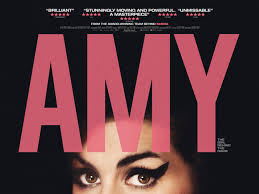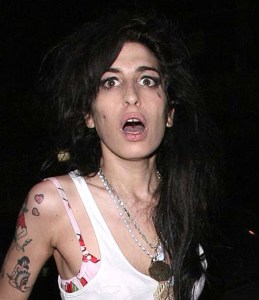Back in my first year of University, I distinctly remember flicking through a copy of the NME to discover that the singer Amy Winehouse, who I had never much cared for, had an arresting new look. I was fascinated with her style, the clashing cultural references – 1960s beehive, Skinhead Fred Perry and braces, ghetto girl gold hoops and sailor’s tattoos – adding up to something totally unique, and to my nineteen-year old self, winningly cool. Later, I asked my best friend “Have you seen Amy Winehouse recently?!” She had, and was also taken with the makeover. I still don’t like her music though, I had mused. However, the new look was the heralding of a new sound for Winehouse. I remember the content of the article well, and the stories she told – of listening to the Shangri-Las lying on her kitchen floor with a bottle of vodka, of a love affair gone wrong and playing pool all day with boys in the boozers of Camden – would become almost as synonymous with Amy as the beehive and winged eyeliner. My interest was piqued, and I sought out her new material with curiosity.
The new documentary depicting her rise to fame and fall from grace, Amy, poses some interesting “what if?” questions around this musical evolution. Shown in interview around the time of the release of her debut album Frank, Winehouse states that she will never be properly famous because she is a jazz musician, and there isn’t the audience for her work. It is obvious that this doesn’t bother her at all. In another interview her first manager Nick Shymansky pinpoints the moment where he believes there was an opportunity for disaster to be averted. Amy had been drinking heavily and avoiding working on her second album when he staged an intervention to try and get her to seek help at a residential rehabilitation unit. This was the event that inspired her first hit single Rehab, and it was Mitch Winehouse – the ‘daddy’ who thinks she’s fine – who halts the plans and decides she doesn’t have to go after all. Shymansky observes that if she had got help at this time there may never have been the Black to Black album, but she would have had an opportunity to get healthy out of the limelight. With so many problems before fame hit – depression, bulimia, alcoholism, and destructive relationships – what hope did she have of getting better once she was in the view of the world’s media?
Her growth as a songwriter and the development of her musical repertoire were the very things which led to both her success and destruction. Because while her amazing voice seems to have arrived fully formed – we see footage of an incredibly self-assured eighteen year old Amy singing and playing guitar for record company execs – Frank was a fairly niche coffee table concern, and if she had emulated its style on her follow up she would almost certainly have not been an international superstar, and most likely another talented but underachieving British soul singer. It is also questionable whether she would have had the success she did if she had not worked with Mark Ronson. But work with him she did, and we are treated to some wonderful footage of her in the studio recording a perfect version of Black to Black for him in one take. It is telling that around the time of the release of Black to Black she calls jazz an elitist genre of music, having been inspired by the guitar bands of Camden, but before her death she was apparently planning to go back to her roots, seemingly wishing to return to the small jazz clubs of her early career.
Director Asif Kapadia has amassed a wealth of footage, including home videos, interviews from promotional tours, concert footage, the recollections of her friends and family and the (often tipsy) messages she left on their phones. Like many fans of Winehouse, I had become bored of her due to the relentless overexposure, both before and after her death. The length of time Amy was trailed by the tabloids, relapsing again and again, meant we all got sick of her, as if she were our own erstwhile friend who kept letting us down. However, the combination of the time since her death and the skill of the director makes this familiar story fresh again. At one and a half hours, the film is a triumph of great editing, bringing out the various plots – the doomed love affair with Blake, dubious actions by family and management, her descent into hard drug use – with both skill and subtlety.
Mitch Winehouse has of course objected to his depiction in the film and threatened to take legal action. However, how he will argue his case is anybody’s guess, as the film’s representation of him is mainly limited to footage of him already within the public arena. Once scene shows him nagging Amy to have her photo taken with some fans on the beach when he brings a camera crew to St Lucia where she is trying to get clean. He can hardly complain of being stitched up – here he is on camera, filming her for a TV documentary called My Daughter Amy and exposing her to more intrustion in return for what can only be personal gain, in the form of financial reward or public attention. A few members of her inner circle point the finger at Mitch for putting pressure on Amy to perform the humiliating show in Belgrade in 2011 where she is incapable of performing and is booed of the stage, and are clear that she had not wanted to do the show. Though beyond this there is no direct accusations or overt criticism of him as a father. In fact, the most shocking example of parental neglect is from an interview with Amy’s mother, when she admits that a fifteen year old Amy told her she had a great “new diet” which involved eating as much as you wanted before throwing it all up. Janis Winehouse says she didn’t think much of this confession, and put it down to a “phase that would pass.”
In her review for The Sunday Times, Camilla Long complained that the depiction of Mitch is “infuriatingly non-judgemental” and the film as a whole “less an insight into the singer’s downfall and death, more a well-curated, noncommittal collection of moments.” This is actually where the film’s strength lies – letting the story tell itself, without unnecessary embellishments, theorising or conspiracy theories. Amy was special enough, and her story sad enough, to keep us gripped without additional sensationalism.
And my, is it sad. I felt much more emotional than I expected to feel, after the years of Amy fatigue. It is less her death than the hopeless spiral of addiction which is so heart-breaking, its awful repetitive cycle and depravity. Seen in chronological sequence, images of her physical decline are quite shocking, a haunting visual depiction of a young woman who has declared war on her body. A series of pictures presumably taken by Amy herself while in the nadir of her crack den days are genuinely grotesque. It is that squalidness that beings the tears down my cheeks, a reminder that addiction can happen to anyone and ruins young lives and tears families apart, the so-called ‘war on drugs’ having failed so miserably to actually get people to stop taking them. The director then juxtaposes this footage with clips of Frankie Boyle and Graham Norton making jokes at Amy’s expense on TV. Of course this is par for the course and it is not a question of saying that the nasty comics shouldn’t be mean to poor Amy. But it does neatly reflect that within our society there is still a notion that addicts simply choose to keep using, because they are bad people who are happy to let the people they love down, despite all the evidence we have to the contrary. Even when she was clean, her pleasure receptors were so mangled she could no longer delight in normal things. Upon winning a Grammy award, she tells her childhood best friend that the whole thing is “so boring” without drugs.
I watch the film in a quiet Sunday afternoon showing at the Cameo, where two very cute, but slightly irritating, women sit watching enraptured next to me. They giggle, whisper, weep, hold each other’s hands and hiss when the baddy Blake appears on screen. Although Amy it is a compelling and artfully constructed film, this is really one for the fans, where we can fall in and out of love with Amy all over again.



